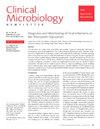难辨梭状芽胞杆菌感染患者酶免疫测定结果的罕见差异
Q3 Medicine
引用次数: 0
摘要
艰难梭菌(clostridiides difficile)大量产生谷氨酸脱氢酶(GDH),该酶常用于艰难梭菌感染(CDI)的筛选。一般来说,gdh -酶免疫分析法(GDH-EIA)的敏感性明显高于毒素免疫分析法。在本报告中,我们描述了一个极其罕见的EIA与gdh阴性和毒素阳性结果差异的病例。核酸扩增显示毒素B基因、二毒基因和tcdC缺失。另外,用培养法监测艰难梭菌的生长情况,结果显示GDH阳性。这些发现表明CDI的实验室诊断具有挑战性。因此,结果应仔细解释考虑到患者的临床过程。本文章由计算机程序翻译,如有差异,请以英文原文为准。
Rare discrepancy in the result of enzyme immunoassay in a patient infected by Clostridioides difficile
Clostridioides (Clostridium) difficile produces glutamate dehydrogenase (GDH) in large amounts, which is frequently used to screen C. difficile infection (CDI). Generally, the sensitivity of GDH–enzyme immunoassay (GDH–EIA) is significantly higher than that of the toxin EIA. In this report, we describe an extremely rare case of discrepancy in EIA with GDH-negative and toxin-positive results. Nucleic acid amplification revealed toxin B gene, binary toxin gene, and tcdC deletion. Additionally, the growth of C. difficile was monitored by culture method, which showed positive result for GDH. These findings indicate that laboratory diagnosis of CDI is challenging. Therefore, the results should be carefully interpreted considering the patient’s clinical course.
求助全文
通过发布文献求助,成功后即可免费获取论文全文。
去求助
来源期刊

Clinical Microbiology Newsletter
Medicine-Infectious Diseases
CiteScore
2.20
自引率
0.00%
发文量
35
审稿时长
53 days
期刊介绍:
Highly respected for its ability to keep pace with advances in this fast moving field, Clinical Microbiology Newsletter has quickly become a “benchmark” for anyone in the lab. Twice a month the newsletter reports on changes that affect your work, ranging from articles on new diagnostic techniques, to surveys of how readers handle blood cultures, to editorials questioning common procedures and suggesting new ones.
 求助内容:
求助内容: 应助结果提醒方式:
应助结果提醒方式:


